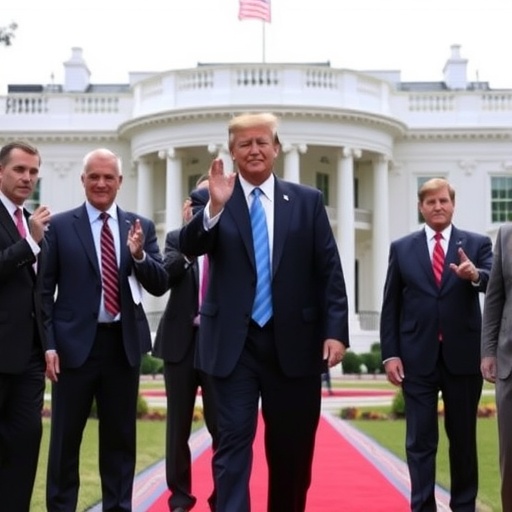In a bold display of party solidarity, Senate Republicans gathered at the White House on Tuesday to confer with President Trump, signaling unwavering support as the Government shutdown stretches into its fourth grueling week. The meeting, attended by key GOP leaders, underscores the deepening partisan divide over funding disputes, with no immediate resolution in sight for the impasse that’s left hundreds of thousands of federal workers without paychecks.
- Senate Republicans Close Ranks in White House Strategy Session
- Trump’s Firm Stance on Border Wall Ignites Shutdown Flames
- Democrats Dig In on Health Care Subsidies and Funding Protections
- Economic Ripples and Public Backlash Mount as Shutdown Persists
- Path Forward: Looming Deadlines and Bipartisan Breakthrough Hopes
The ongoing Government shutdown, now the longest in U.S. history, has been fueled by clashing demands on border security and domestic spending. President Trump has insisted on billions for a southern border wall, while Democrats prioritize protections for health care subsidies and averting cuts to essential programs. As the clock ticks toward potential economic fallout, this White House huddle represents a strategic pivot for Senate Republicans to reinforce their stance and pressure opponents.
Senate Republicans Close Ranks in White House Strategy Session
Inside the ornate West Wing, President Trump hosted a cadre of Senate Republicans, including Majority Leader Mitch McConnell and several committee chairs, in what insiders described as a “unity summit.” The gathering, which lasted over two hours, focused on coordinating messaging and legislative tactics to break the deadlock. Sources close to the meeting revealed that Trump reiterated his non-negotiable position on wall funding, estimating it at $5.7 billion, while emphasizing the shutdown’s role in highlighting national security threats.
“We’re standing firm with the President because the American people deserve secure borders,” McConnell told reporters outside the White House, his tone resolute. This unity comes at a critical juncture; polls from Pew Research Center indicate that 53% of voters now blame both parties equally for the shutdown, but Republican support for Trump’s approach has held steady at 85% among GOP voters, according to a recent Quinnipiac survey.
The session also delved into contingency plans for upcoming votes. Senate Republicans, who hold a slim 53-47 majority, are preparing to advance a short-term funding bill that includes wall provisions, potentially forcing Democrats into a tough vote. However, with Speaker Nancy Pelosi controlling the House, any such measure faces certain defeat, prolonging the Government shutdown further.
Historical context adds weight to this meeting. The last major government shutdown in 2013-2014 lasted 16 days and cost the economy an estimated $24 billion in lost productivity, per the U.S. Travel Association. Today’s standoff, surpassing that mark, has already inflicted $11 billion in damages, according to the Congressional Budget Office, with daily losses mounting at $160 million.
Trump’s Firm Stance on Border Wall Ignites Shutdown Flames
At the heart of the crisis is President Trump’s unyielding demand for border wall funding, a cornerstone of his 2016 campaign promises. During the White House meeting, Trump reportedly shared vivid anecdotes from border agents about drug trafficking and illegal crossings, framing the wall as essential to curbing the opioid epidemic that claims 130 lives daily in the U.S., per CDC data.
“This isn’t about politics; it’s about protecting our families,” Trump declared in a post-meeting tweet, tagging Senate Republicans who attended. His administration has pointed to a 20% drop in illegal crossings in sectors where wall prototypes exist, though critics from the American Civil Liberties Union argue such claims overlook broader immigration trends influenced by Mexican economic factors.
The government shutdown has amplified Trump’s narrative, allowing him to portray Democrats as obstructionists. Yet, internal GOP memos leaked to Politico suggest some senators, like moderate Susan Collins of Maine, are quietly advocating for compromise to mitigate backlash in swing districts. Collins, who did not attend the meeting, issued a statement emphasizing the need for “bipartisan solutions that address humanitarian concerns at the border.”
Economically, the shutdown’s ripple effects are stark. The Department of Homeland Security reports that 800,000 federal employees are furloughed or working without pay, including TSA agents and national park rangers. In a poignant example, Smithsonian museums have shuttered, denying 30 million annual visitors access to treasures like the Hope Diamond, leading to an estimated $100 million in lost tourism revenue for Washington, D.C. alone.
Democrats Dig In on Health Care Subsidies and Funding Protections
Across the aisle, Democrats remain steadfast, refusing to budge on safeguards for health care subsidies and other social programs. House Speaker Nancy Pelosi, speaking from Capitol Hill, lambasted the White House gathering as a “photo op for division,” insisting that any funding bill must exclude wall money and preserve Affordable Care Act subsidies that assist 7 million low-income Americans.
The battle over health care subsidies stems from Republican efforts in prior budgets to repeal parts of Obamacare, a fight Trump has vowed to reignite. Democrats cite Kaiser Family Foundation data showing that subsidy cuts could raise premiums by 10% for middle-class families, potentially uninsured 4 million more people. “We won’t let this shutdown become a Trojan horse for dismantling health care,” Pelosi said, vowing to rally her caucus against any compromise.
This intransigence has stalled negotiations. A bipartisan Senate resolution proposed last week, which would fund the government through March while forming a border security commission, garnered 49 votes but fell short due to Republican defections. Senate Minority Leader Chuck Schumer highlighted the human cost, noting that IRS refunds are delayed, affecting 160 million taxpayers expecting $270 billion in returns this season.
Broader impacts include strained food safety inspections, with the FDA halting routine checks on 80% of imported seafood, raising public health alarms. Veterans Affairs hospitals, operating on borrowed funds, warn of potential service disruptions for 9 million enrollees if the shutdown persists.
Economic Ripples and Public Backlash Mount as Shutdown Persists
As the government shutdown drags on, its economic scars deepen. Moody’s Analytics projects a 0.1% GDP hit for every week of closure, potentially shaving 0.4% off annual growth if unresolved by February. Small businesses near federal sites, like those in Arlington, Virginia, report 30% sales drops, per the National Federation of Independent Business.
Public sentiment is souring. A Monmouth University poll shows approval for Trump’s handling of the shutdown at a mere 34%, with 62% of independents urging compromise. Senate Republicans, feeling the heat, have launched ad campaigns in key states framing Democrats as the villains, but effectiveness wanes as food pantries see a 15% uptick in federal worker clients, according to Feeding America.
International eyes are watching too. The World Bank has flagged the U.S. shutdown as a risk to global stability, potentially eroding confidence in American bonds. Domestically, credit rating agency Fitch warns of long-term fiscal strain if partisan gridlock becomes normalized.
Personal stories humanize the crisis. Coast Guard Lt. Cmdr. John McKinley, working without pay, shared in a viral op-ed: “My family is dipping into savings for groceries, but how long can we last?” Such narratives pressure lawmakers, yet both sides accuse the other of grandstanding.
Path Forward: Looming Deadlines and Bipartisan Breakthrough Hopes
Looking ahead, the shutdown’s resolution hinges on upcoming milestones. The Treasury Department has until mid-February to exhaust extraordinary measures for debt ceiling compliance, adding urgency to talks. White House officials hint at possible Trump concessions, like reallocating military funds for the wall, though legal challenges loom from states like California.
Senate Republicans plan procedural votes this week to test Democratic resolve, potentially teeing up a veto override scenario if a clean funding bill passes. Bipartisan groups, including the Problem Solvers Caucus, are drafting alternatives that tie wall funding to asylum reforms and health care subsidies extensions, offering a glimmer of hope.
Experts like Brookings Institution fellow William Galston predict a messy endgame: “Pressure from unpaid workers and midterm ghosts will force a deal, but not without scars.” If no agreement by Valentine’s Day, Treasury warns of delayed Social Security payments, affecting 65 million seniors—a political powder keg.
For now, the Trump-led unity among Senate Republicans at the White House buys time, but the fourth week of shutdown underscores a fractured Washington. Stakeholders from Wall Street to Main Street await signals of thaw, as the nation’s machinery grinds slower with each passing day.








